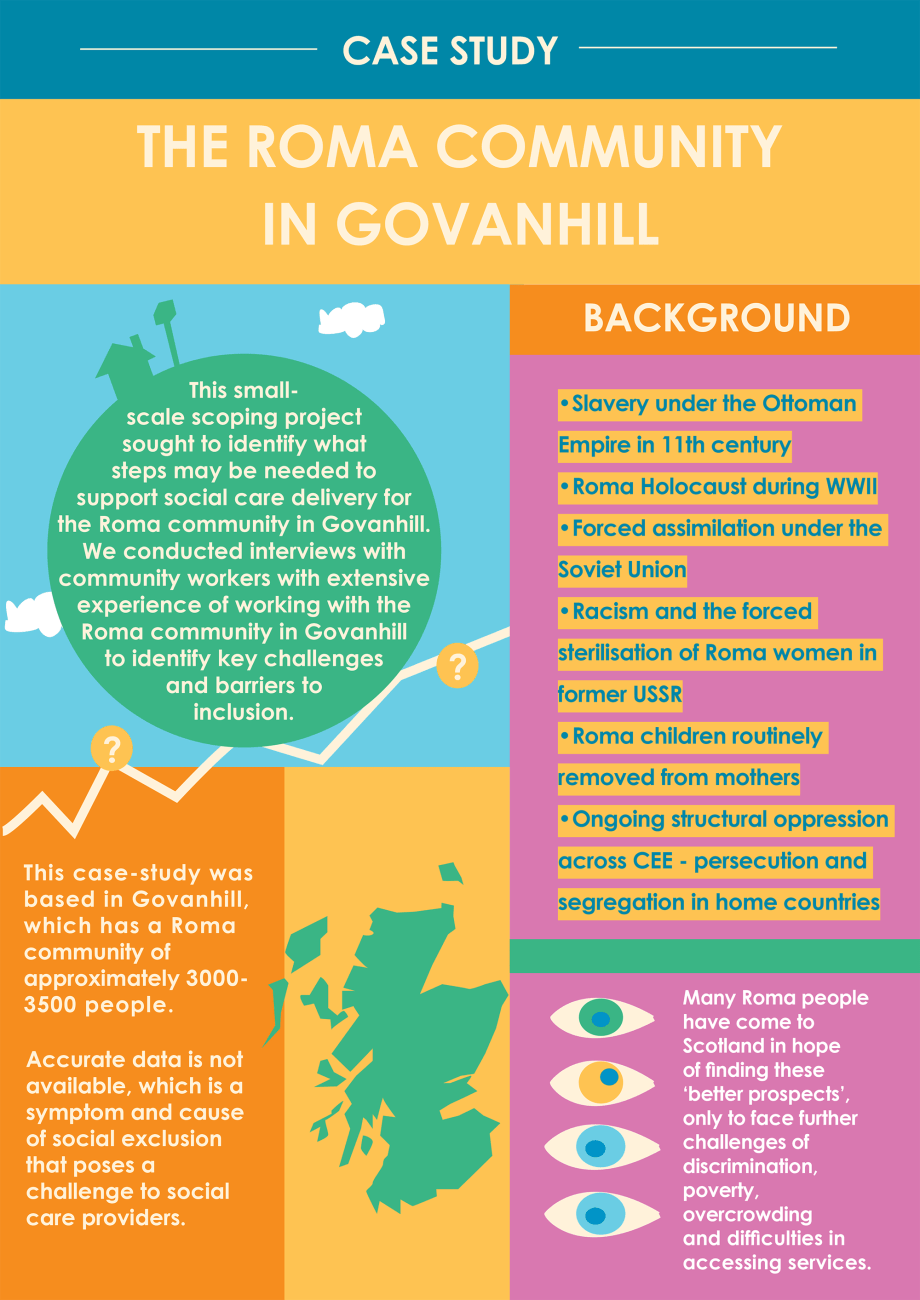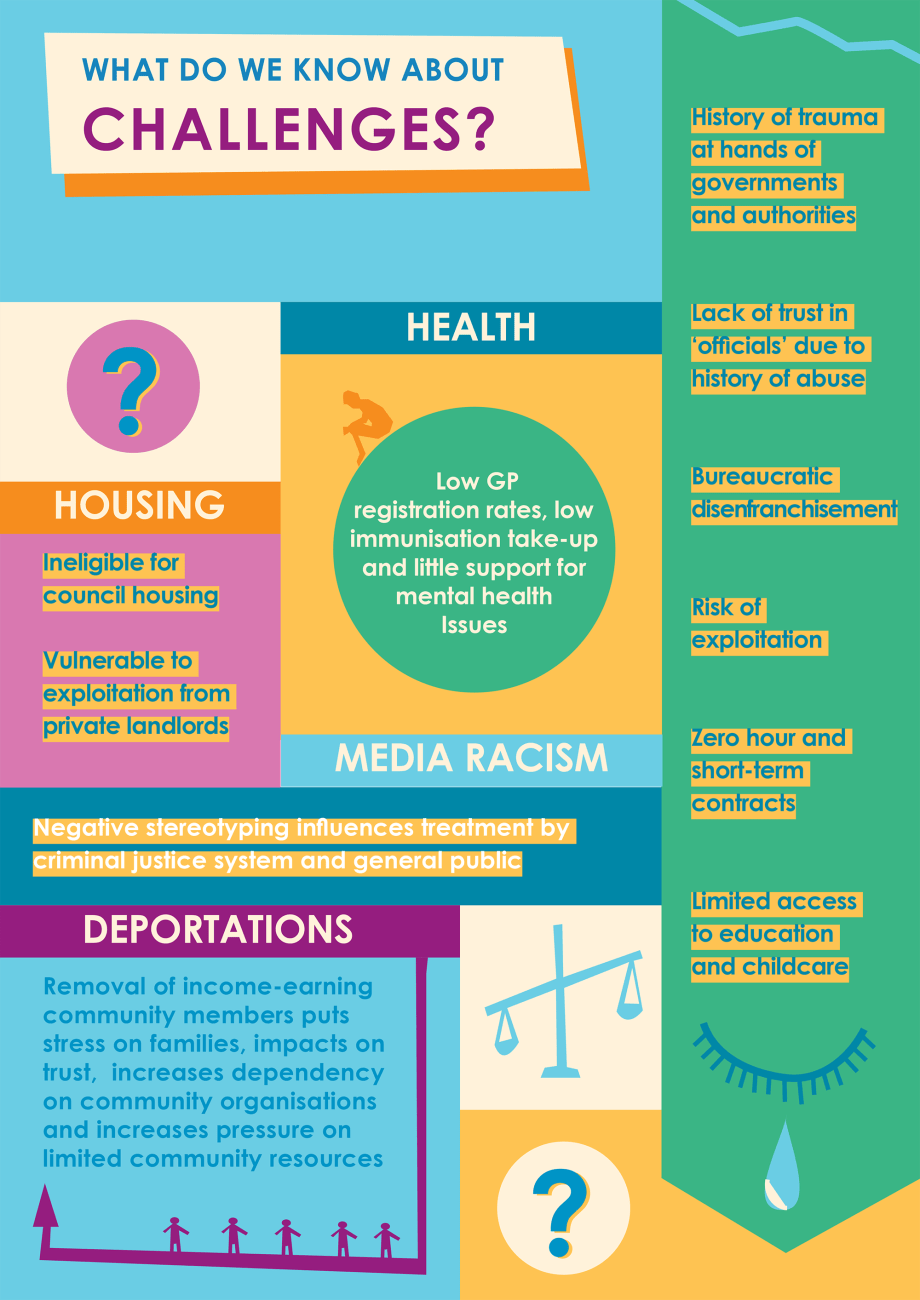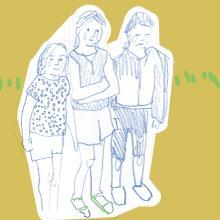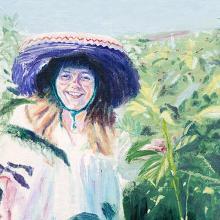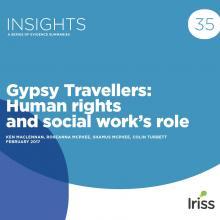About the project
This three-month project was inspired by the Iriss Insight exploring social work’s role in upholding the human rights of Scottish Gypsy Travellers. The Insight highlighted the need for state agencies including those involved in health, social care and social work, to incorporate culturally competent practice into their services to Scottish Gypsy Travellers. It is important for all social services providers to consider how to engage participation from Scottish Gypsy Travellers, for example, staff and foster carer recruitment, local and national policy makers, and local user forums. (MacLennan et al, 2017).
As part of our development of co-production support and resources at Iriss, we wanted to expand this learning to encompass the Roma community alongside the Gypsy Traveller community, in order to consider the similarities and differences of approach required.
Initially the project plan was to create a series of ‘creative case studies’ showcasing best practice in social care in Govanhill. We hoped to engage local Roma people to ‘co-produce’ this scoping exercise- to ensure we were asking the right questions and to be led by the Roma community.
Our approach
We were able to speak with a number of staff from local and national organisations who work directly with Roma people. Some of these people are Roma themselves, and others have significant experience of working with the Roma community. We thank them for their time and insights, which gave us the opportunity to identify what approaches are currently working well and how some barriers to inclusion might be overcome.
It is important to acknowledge the limitations of this report: it was conducted within a limited timescale; we did not employ a Roma person to undertake the work, we did not have an interpreter and we had not established partnerships with local organisations. This means that regrettably we were not able to co-produce the report with people living in Govanhill. However, we were able to collaborate with professionals within third sector organisations to provide some insight into the lived experiences of people in the Govanhill Roma community.
Setting the scene
This report provides an insight into the challenges faced by the Roma community in Govanhill, Glasgow, which has a Roma community of approximately 3000-3500 in 2014 (Clark, 2014). Based on the challenges identified, we provide recommendations for national, local and service-level changes that need to be made to support improvements in the inclusion and representation of Roma communities in society.
Roma residents are often considered to be a ‘hard to reach group’. While we are not in doubt that there are sections of population that are ‘not engaged fully in an active participatory citizenship process’, we want to clarify that barriers to inclusion do not equate with an inherent reluctance of these groups to be reached (Poole and Adamson, 2008).
The identification of these issues is not an attempt to justify the lack of services and bespoke outreach work done to engage Roma communities. Rather we want to acknowledge the role that services can play in learning how to, and being resourced to, work with groups who have different needs from the mainstream. This would encourage fuller engagement, enabling Roma people to take a central role in the design of services to support themselves and their community. We believe that culturally competent outreach work (MacLennan et al, 2017) could overcome the barriers to inclusion we have identified in this report.
Historical context
The Roma ‘community’ comprises a wide variety of languages, lifestyles and cultures, made of groups such as Roma, Sinti, Kale, Gypsies, Romanichels, Boyash, Ashkali, Egyptians, Yenish, Dom, and Lom (Social Marketing Gateway, 2013). Their population in Europe as a whole could be between 10 and 12 million people, forming the largest and most socially excluded ethnic minority group on the continent (Poole and Adamson, 2008).
In terms of their history, the Roma are believed to have migrated from northern India to Europe in the 11th century, enduring centuries of slavery under the Ottoman Empire. They achieved emancipation in the mid-19th century, only to become victims in the Porajmos or Roma Holocaust, less than a century later. Despite approximately 1.5 million Roma people being killed in camps and mass killings by the Nazi regime, the Romas’ persecution in the Holocaust was little more than a footnote until the 1990s.
Since the Second World War, the Roma community has seen forced assimilation under the Soviet Union, and since the fall of the USSR has faced racism and the forced sterilisation of Roma women. Roma children were routinely removed from their mothers, placed with non- Roma families, state institutions or ‘special schools’, where they were labelled ‘mentally retarded’ (Poole and Adamson, 2008). As a group they were categorised according to the criteria laid down by the state social services on the basis of data collected by the state. This categorisation often happened without their knowledge and/or consent, a critical factor in their understandable distrust of ‘officials’ (Poole and Adamson, 2008).
This history of structural oppression and genocide is not confined to the past, as ‘the history, legacy and continuation of anti-Roma prejudice and discrimination across CEE ensure that many Roma families will keep leaving their home countries for better prospects abroad’ (Clark, 2018). Many Roma people have come to Scotland in hope of finding these ‘better prospects’, only to face further challenges of discrimination, poverty, overcrowding and difficulties in accessing services.
Borders
The current Roma community in Govanhill has a majority of Romanian Roma. This is a significant shift from six years ago, when the largest group in the community were Slovakian Roma. This population shift may be ascribed to the expansion of the EU, the accession of the A8 countries (of which Slovakia is one) to European Union in 2004, followed by the A2 countries, Bulgaria and Romania, in 2007. This accession gave the citizens of these countries the right to move to Britain to work (ILPA, 2010).
Migration within the EU is often framed as voluntary and driven by economic factors. Voluntary migrants, should they not find the opportunities or quality of life they hoped for in a new country, can return to their ‘home’ country (Poole and Adamson, 2018). Roma people are not voluntary migrant in this traditional sense; they have suffered and continue to suffer persecution and segregation in their home countries and do not benefit from the freedom to safely return (Poole and Adamson, 2018).
While free movement to the UK was granted to these new member states, a series of welfare and work restrictions were placed on new arrivals.
Until 2014, migrants from the A10 countries could only gain unrestricted access to the UK labour market and benefits support upon completing 12 months ‘continuous and lawful’ employment. Before this 12-month period, they had no access to benefits or state support (ILPA, 2010). Because of the short-term nature of much of the employment available to the Roma community, sustaining 12 months continuous employment was difficult. For A8 Nationals, periods of unemployment also meant restarting of the entire Workers’ Registration process, including forms and application fees. For A2 nationals, the Workers’ Authorization Scheme entailed even more stringent restrictions; migrants needed registered employment in place before coming to the UK and were limited to the kinds of jobs they could do (ILPA, 2010).
These restrictions had serious, negative and long-term impacts on the lives of Roma people in Scotland by driving them into destitution. Even when restrictions were lifted in 2014, the Roma community in Govanhill continued to feel their impact (Paterson, 2011).
Community workers interviewed for this report stressed that the vote to leave the European Union in June 2016 has increased the sense of insecurity amongst the Roma communities that they work with. They suggested that there has been a significant spike in administrative deportations and detentions of members of the Govanhill Roma community.
Deportations target members of the community who have criminal records and are unable to exercise treaty rights, which they only have access to if they are in employment, or receive benefits at the time of their arrest. Community members suggest that these deportations are a result of collusion between immigration enforcement officers and Police Scotland, as well as police working undercover. This indicates significant potential for such deportations to be highly destructive to the relationships between the Roma community and law enforcement and authority figures more generally.
Community workers struggle to find expertise in this area to help the deported, detained and their families. Legal support is difficult to access as immigration lawyers do not conventionally work with EU citizens, and advice bureaus for EU citizens have little experience of deportations. If a family member, commonly an adult male, is deported then a source of income and support for a family is lost, and destitution threatens.
Bureaucracy
The impact of the complex laws and systems illustrated above is that they deter marginalised and deprived communities from accessing the supports which they are entitled and which mitigate against the deprivation they experience. This is particularly pertinent in cases where a community with low literacy levels in their own language are forced to engage with complex bureaucratic systems, which many native English speakers struggle to navigate (Jacob, 2016).
Roma people frequently experience delays in benefits processing, with documents being detained for months or even years at a time and a very high proportion of benefits refusals being later overturned (Paterson, 2011). Evidence has also emerged of discriminatory practice by HMRC and DWP towards Roma people, with an unwarranted number of claims being sent to the Compliance Team which was set up to monitor fraud and select claims to examine at random (Paterson, 2011). Roma people are also subjected to refusals and negative treatment by HMRC/DWP staff based on the erroneous belief that restrictions on A8 and A2 nationals’ recourse to public funds continue to apply (Paterson, 2011).
David Zabiega of Govanhill Community Development Trust, brought to our attention that this difficulty in accessing benefits has a knock-on effect for the whole community in terms of allocation of resources. This is due to to the use of the Scottish Index of Multiple Deprivation (SIMD) in registering information about the Roma population in the area. The SIMD is used by Scottish Government, local authorities and the NHS to inform policy, resource allocation and targeted services. SIMD ranks areas according to measurements of deprivation across seven different ‘domains’: income, employment, health, education, housing, crime and access. Income and employment are by far the most heavily weighted, both at 28%, with health following at 14%. Income and employment are measured by the number claiming certain benefits, such as Employment Support Allowance, Universal Credit and Jobseekers’ Allowance (Scottish Government, 2018).
Given the barriers to accessing the welfare system that the Roma community in Govanhill face, significant sections of Govanhill will not be registered by the SIMD as suffering from deprivation in the categories of income and employment.
Media racism
These multifaceted challenges faced by the Roma community are often seized upon by the media in order to reinforce a long standing racism towards Roma people, sometimes described as ‘Romaphobia’. The Scottish media follow the wider patterns in European media and continues to reinforce the stereotype of Roma people as criminals who live in ghettos and are in conflict with ‘locals’ (Tremlett, 2017).
For example, a recent Times article featured the headline ‘Children Sold for Sex on Streets of Govanhill’ (Horne, 2017). Police Scotland and Justice Secretary Michael Matheson stated that there was ‘no evidence or intelligence to substantiate the allegations at the present time’. Community group Friends of Romano Lav (FoRL) responded robustly to the ‘spurious and unevidenced’ allegations and highlighted the extent of racialization of child protection issues in the Times article (Glasgow Live, 2017).
Friends of Romano Lav observed that such negative and inaccurate media coverage damages community relations, cohesion and development work done in the area. Such racism has real and material impacts on the ability of Roma people to find employment, access education and integrate into wider society. Although statutory bodies have a responsibility to investigate such serious claims, false reporting and folk demonization of particular social groups places considerable strain on social services workloads, as well as damaging the work done by them to develop trust from the Roma community. Such racism also affects local cohesion and community building. It is unfortunately not unusual to see slogans such as ‘Roma Out’ graffitied on posters, phone boxes and walls around Govanhill.
Poverty
The material effects of the bureaucratic disenfranchisement discussed above are a contributing factor to the poverty that disproportionately affects the Roma population (Poole and Adamson, 2008). A recent briefing on the situation of the Roma Community in Govanhill, Glasgow (Poole and Adamson, 2008), commissioned and funded by the Glasgow South East Community Health and Care Partnership and Oxfam, highlights the following:
- Roma are mainly in part-time, temporary employment, outwith mainstream structure as a result of their exclusion from public sector employment services and reliance on ‘gangmasters’ for work and housing. As a result, they are often unable to access the basic in-work benefits such as a contract of employment, a minimum wage, pension rights, paid holidays, maternity leave, and paid sick leave.
- In housing, Roma are particularly vulnerable to private sector dependency due to their employment situation and consequently experience high rents, sub-standard conditions and non-existent tenancy agreements. This leads to overcrowding (as families are forced to pool their resources), evictions, and strained community relations as a result of increased noise and waste.
- Barriers to accessing health services centre around language and culture. These barriers impact on the Roma’s ability to register with GPs and on their understanding of protocols such as booking appointments. Health care professionals have found growing levels of malnutrition amongst children, overcrowding and infestation, all of which carry with them significant public health risks.
- At secondary school level the challenge of increased numbers of Slovak Roma in Govanhill has been even more profound. Here the main issue appears to be attendance and retention. A poor level of commitment to secondary schooling, reflecting cultural and economic realities, hinders the success of the Bilingual Support Unit.
- Many young people, including those with a good command of English, are also disadvantaged by the lack of encouragement they receive from parents and the lack of educational material especially where whole families share one room, as is the case for the overwhelming majority.
Forms of social care
While circumstances for the Roma Community in Govanhill are highly challenging, there are many organisations in the area doing valuable work in providing services and support (Clark, 2014). One community worker described the social care provision in Govanhill as being a ‘cloud’ formation, with statutory bodies (such as education, healthcare, housing association and social work) at its core, with a number of small, grassroots organisations providing activities, advice, training, education, food and clothing around it.
Colin Clark (2014) suggests that some of the most successful ‘on- the-ground’ projects are led by Roma communities themselves, in partnership with Glasgow City Council and other bodies. Although the work and dedication of these organisations is exemplary, there is a sense among organisations that the voluntary and third-sector organisations ‘are always left to pick up the pieces.’ There is also a risk of overlap in the remit and service user pool of some organisations: as is the nature of grassroots groups, many have sprung up organically over the years and have limited resources and capacities.
Based on the assertion that Roma-led projects are those that have been most successful in the area, Clark (2014) suggests:
A louder “bottom-up” Roma voice is needed to guide service provision as well as anti-racism efforts – but this ‘voice’ needs to be plural, not singular, to best represent the diversity of views within and between the exceptionally heterogeneous Roma communities of Europe.
Co-producing the future
Our interviews with community workers provided a useful starting point to identifying key challenges for the Roma community in Govanhill and the social services seeking to support them.
Co-production is called for when solutions need to be found that rely on knowledge from multiple sources, where each member of the co- production team has a skill or knowledge that the other team members need in order to find solutions. (Durose, 2017)
The Roma Community should have a central role in designing the services for their own community using a true co-production model. This should include space to gather information and feedback in regards to the successes and failures of current and previous services. We suggest co- production methodology as a suitable process for moving forward, as there are a number of stakeholders who are essential to developing plans for change and painting a more accurate picture of the potential of social care provision in the area. This should begin with a participatory approach to defining the ‘questions’ to be answered. Following a robust co- production methodology, such as that outlined in the Iriss Co-production project planner (2018), ensures that the voices of the community are heard and their needs are effectively addressed (Iriss, 2018).
Policy makers and social service providers would benefit from increased awareness of the detrimental effect of negative media portrayals, racism, deportations, political agendas and structural oppressions (poverty, bureaucratic disenfranchisement) on the Roma community. We suggest that efforts be made to invite Roma community members to share their knowledge and experiences, and that policy makers meet them on ‘their own turf’ in order to develop a deeper understanding of the situation.
The development of resources, training and educational materials to improve the cultural competency of staff working with the Roma community could improve relationships between the Roma community and social services providers. These should be co-developed and co-delivered by Roma people and staff in order to offer a true reflection of the cultural needs of the community.
Finally, statistical and research models should continue to be critically examined in order to identify their biases. Understanding how they lack cultural competency and unfairly affect resource allocation, funding and policy would be a step towards ensuring that the most marginalised are not ignored.
References
- Clark C (2014) Glasgow’s Ellis Island? The integration and stigmatisation of Govanhill’s Roma population. People, Place and Policy, 8, 1, 34-50 http://bit.ly/2HNaDEb
- Clark C (2018) Roma, Gypsy and Traveller experiences of racism in Scotland. In: Davidson, N, Liinpaa, M and Virdee, S (eds.) “No Problem Here”: racism and Scottish society, Edinburgh: Luath Press Ltd
- Durose C et al (2017) Generating ’good enough’ evidence for co- production. Evidence & Policy: A Journal of Research, Debate and Practice, 13, 1, 135–151 http://bit. ly/2I01MwH
- Glasgow Live (2017) Roma charity group blasts Govanhill child sex claims. Glasgow Live, 18 November 2017, http://bit.ly/2Hqctvw
- Horne M (2017) Children sold for sex on streets of Govanhill. The Times, 17 November 2017, http://bit. ly/2HqRiW8
- Immigration Law Practitioners’ Association (ILPA) (2010) A8 and A2 free movement information sheet, 21 June 2010, http://bit. ly/2HIc335
- Jacob D (2016) Addressing barriers to healthcare access for Roma: a community development approach. School of Social Work & Social Policy, 64 2, 157–177, http://bit. ly/2KcCRXi
- MacLennan et al (2017) Gypsy travellers: human rights and social work’s role. Iriss Insight 35, http://bit. ly/2HJNjr9
- Paterson L et al (2011) Unequal and unlawful treatment: barriers faced by the Roma community in Govanhill when accessing welfare benefits and the implications of section 149 of the Equality Act 2010. Glasgow: Oxfam Law Into Practice/Govanhill Law Centre, http://bit.ly/2JpaNyM
- Poole L and Adamson K (2008) Report on the situation of the Roma community in Govanhill University of the West of Scotland. Scottish Universities Roma Network/University of the West of Scotland, http://bit.ly/2qYLkFJ
- Social Marketing Gateway (2013) Mapping the Roma community in Scotland: final report, Glasgow: The Social Marketing Gateway/Glasgow City Council, http://bit.ly/2HXD3sV
- Scottish Government (2018) Using SIMD, http://bit.ly/2HQ5rj5
- Tremlett A et al (2017) Romaphobia and the media: mechanisms of power and the politics of representations. Identities: Global Studies in Culture and Power, 24, 6, 641-649, http://bit. ly/2HqgVGE
- Vallely J (2018) The Iriss co- production project planner, http:// bit.ly/2vOAc3a
